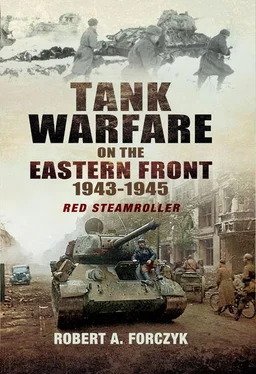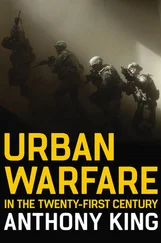Von Manstein was astute enough to recognize that his opponents were over-extended and that there was an opportunity to regain the initiative. He also recognized that Popov’s Armoured Group was the primary threat and should be dealt with first. On the other hand, he had to devote some of his best units, such as Großdeutschland and LSSAH , to defensive tasks to prevent his left flank from collapsing. As an opening move, von Manstein directed the 15.Infanterie-Division, which was arriving by rail from France, to detrain just outside the town of Sinel’nikovo on the evening of 19 February. Assisted by three Marder tank destroyers, the German infantrymen stealthily advanced into the town and caught Pavlov’s 25th Tank Corps completely by surprise; since most of his armour was immobilized by lack of fuel there was little that he could do to stop the sudden German attack. His corps abandoned the town and a good deal of equipment.
Also on 19 February, the SS- Wiking Division finally finished off Poluboyarov’s immobilized 4GTC at Krasnoarmeyskoye, which was virtually destroyed. Poluboyarov managed to escape with dismounted remnants and after 4GTC was rebuilt, he would command this formation for the duration of the war. The next day, the 11.Panzer-Division pushed westward from Konstantinovka across the supposedly impassible Krivoi Torpetz while the 7.Panzer-Division pushed north from Krasnoarmeyskoye; this manoeuvre began to close the jaws around the immobilized 10th Tank Corps and the 18th Tank Corps that Popov had just shifted from his other flank. Although Generaloberst Gotthard Heinrici’s XXXX Panzerkorps had difficulty closing the ring due to the snow and limited forces available, by the night of 21–22 February three of Popov’s tank corps had been effectively destroyed, although thousands of troops escaped. Given the limited number of tanks available and their unwillingness to close in on desperate encircled troops, the PzAOK 1 counter-offensive relied heavily on stand-off firepower, using artillery and 8.8cm Flak guns to pick off Soviet tanks and vehicles from a distance. For their part, the trapped Soviet tank corps tried to conceal their T-34s inside villages, protected by the remaining infantry, thereby forcing the Germans to fight their way into some towns. However, the real reason that the Soviet tank corps collapsed so quickly – aside from the obvious shortages of fuel, food and ammunition – was their lack of effective artillery support. By this point, Popov’s tank corps had lost their attached multiple rocket launcher battalions and the only remaining artillery left to defend their hedgehogs were small numbers of 76.2mm field guns and 82mm mortars. By 24 February, PzAOK 1 had rolled up Group Popov and demolished it piecemeal. With their vehicles and tanks smashed, Popov’s tankers began the long walk back through the snow to the Donets.
On 20 February, Hoth ordered the Das Reich and Totenkopf to begin attacking the flank of the 6th Army south of Krasnograd. Das Reich only had 41 operational tanks (33 Pz III, 7 Pz IV, 1 Tiger) and 15 StuG III, but Totenkopf was nearly full strength with about 100 tanks and 20 assault guns. The LSSAH , which had 73 operational tanks (10 Pz III, 45 Pz IV, 12 Pz II, 6 Tiger) and 22 StuG III and was sent to aid the hard-pressed Generalkommando z.b.V. Raus in its efforts to delay Rybalko’s push westward from Kharkov. The attack began at 0500 hours, with columns of tanks and vehicles probing cautiously forward through thick, white fog. Initially, the SS-Panzerkorps was opposed by elements of two of 6th Army’s rifle divisions, but very little armour. By noon, the sky had cleared enough for Ju-87 Stukas to provide close air support sorties, which helped to smash up Soviet positions in towns. The Das Reich was also fortunate to have some of the new Wespe 10.5cm self-propelled howitzers, which provided excellent mobile fire support. Only a single Tiger, from Das Reich , participated in the attack, but it enjoyed considerable success, destroying 11 anti-tank guns and four T-34s in the first two days. This Tiger spearheaded the attack into Pavlograd on 21–22 February, which put paid to the 25th Tank Corps. Due to ignorance about the impending German counter-offensive, Vatutin had never ordered these forces to shift to the defence and they were caught unprepared by the sudden arrival of German mechanized units. Elements of four Russian rifle divisions were isolated south of Pavlograd, which required considerable mop-up operations. The 6. and 17.Panzer-Divisionen, subordinate to the XXXXVIII Panzerkorps, arrived south of Pavlograd and assisted the SS-Panzerkorps in crushing one isolated Soviet unit after another. Here and there, a few T-34s and anti-tank guns put up a fight and cost the Germans some vehicles, but superior firepower and manoeuvre carried the day.
Although the Soviet spearheads nearest the Dnepr were relatively easy to dispose of, the 6th Army established a coherent defensive position at Lozovaya with General-major Aleksandr V. Kukushkin’s 1st Guards Tank Corps and the 48th Guards Rifle Division. Hoth’s basic plan was to conduct a frontal assault on Lozovaya with Das Reich , while Totenkopf manoeuvred around to isolate the town. As part of this effort, the II./SS-Pz. Regt. 3 sent one of its companies in a movement to contact west of Lozovaya on the night of 24–25 February; this was a tank-pure team with no infantry or artillery support. Even worse, the tanks were low on fuel and ammunition. Moving tanks in hostile territory at night without proper reconnaissance is very reckless and before long SS-Hauptscharführer Fritz Biermeier’s 6 Kompanie was lost. However, the SS tankers continued to press on and just before dawn they blundered into a group of Kukushkin’s T-34s. A short, sharp tank action ensued, with losses on both sides. While recovering from the action, Biermeier’s company was next surprised by Soviet cavalry, who killed and captured some of his crews while they were outside working on their damaged tanks. {55}
Capping off this tactical fiasco, the Das Reich managed to lose one of its three operational Tigers on 25 February in a singular act of stupidity not uncommon among tankers. Tankers are often proud of their mounts and are prone to brag about them to outsiders. SS-Hauptsturmführer Friedrich Herzig, who like many SS tank leaders had no prior experience with tanks, had only been commander of Das Reich ’s Tiger company (8./SS-Pz. Rgt. 2) for a week when he made a bet with some Luftwaffe officers that his 54-ton tank could cross a frozen river. Apparently, Herzig failed to notice that a thaw had begun the previous day and that the ice was thinning. After moving only a short distance on to the ice, the Tiger broke through and sank up to the top of its turret. It took three days of effort to recover this Tiger and then the water-logged vehicle, with its electrical system ruined, had to be sent back to Kassel for repair. The report on this embarrassing incident went all the way up to Hitler, who was not amused. [14]
The first part of von Manstein’s counter-offensive culminated with the Battle of Lozovaya on 26–27 February. Since the Das Reich only had 19 operational tanks left, it relied heavily on its artillery, assault guns and Stuka attacks to reduce the Soviet defences. Kukushkin’s tanks were well hidden in the town and put up a tough fight, supported by plenty of anti-tank guns. Kukushkin even managed a counter-attack with his T-34s, but six were quickly knocked out. By 27 February, the Germans had occupied Lozovaya and completed the destruction of Vatutin’s spearheads. Recognizing defeat, Vatutin ordered the survivors to pull back toward the Donets. Von Mackensen’s 1. PzAOK also kept up the pressure on 1st Guards Army, recovering much of the ground lost at the start of Operation Gallop.
Читать дальше








![John Stieber - Against the Odds - Survival on the Russian Front 1944-1945 [2nd Edition]](/books/405234/john-stieber-against-the-odds-survival-on-the-russian-front-1944-1945-2nd-edition-thumb.webp)



